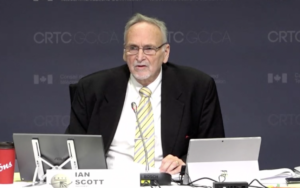A five-day CRTC hearing on the proposed $26 billion acquisition of Shaw Communications by Rogers Communications Inc. (RCI) got underway Monday with Edward Rogers and Brad Shaw promising to honour the legacy of their visionary fathers.
“My father, Ted Rogers, and Brad’s father, JR Shaw, started their companies from almost nothing, invested and risked everything. They were visionaries. They were builders. They were incredibly proud to work, live and invest in Canada,” said Edward Rogers, the reinstated Chair of RCI, following a court battle earlier this month.
“I grew up, like Brad, in the business from the bottom up and learned early-on that the licences our companies hold are a public commitment and responsibility. Over the decades when we give our word, we know the absolute importance of delivering on those promises,” he continued. “The commitments Rogers and Shaw will make around this proposed merger is no different.”
Edward Rogers said Canada is no longer an island and while Bell and Telus are the company’s primary competitors in cable, increasingly its competitors are global platforms and brands.
Brad Shaw, Executive Chair & CEO of Shaw, opened by reflecting on the flooding in British Columbia, saying the company recognizes the industry has a role to play in recovery by investing in extended networks.

“I know both Edward and I strongly believe in improving connectivity in Canada. That is just part of our shared vision that brings us before the Commission today,” Shaw told the hearing. “In 1970, my father, JR Shaw, embarked on a new venture and risked everything we had to launch Capital Cable in Sherwood Park, Alberta…at every step along the way, JR, our family, and our employees have always put our customers and communities first. Our decision to combine our company with Rogers was no different. As we looked to the future – something JR always insisted we do – it became clear that our company, our industry, and our country are at a critical turning point. Without significant network investments in wireline and wireless, it will be impossible for Shaw to meet the evolving needs of Canadians, expand to serve more communities, and continue to put the needs of our customers first. Simply put, Shaw cannot do it alone. We need the scale, strength and resources of the combined Shaw and Rogers assets.”
RCI is pitching the deal as a way to overcome the challenges of the digital age by enhancing competition in the Prairie provinces and B.C., through a $2.5 billion 5G network investment in the west and investing in IPTV platforms to strengthen the company’s ability to provide an alternative to the global media giants “threatening the business models and sustainability of Canada’s broadcasters and distributors.”
It’s also promising to bridge the digital divide between urban and rural communities by spending $1 billion on the creation of the Rogers Rural and Indigenous Connectivity Fund, dedicated to connecting underserved communities across the west, and extending its internet and TV affordability program, Rogers’ Connected for Success.
Customer migration
RCI’s strategy to migrate Shaw customers is to “marry” linear and streaming options so customers can access all of their programming through the same platform.
“Almost 28 million Canadians now watch streaming services like Netflix, Amazon Prime Video or Disney+. Millions of households also rely on a digital cable subscription to access their favourite TV shows and news and sports programming,” said Eric Bruno, SVP Content and Residential Products, Rogers. “By providing seamless access to both linear channels and digital streaming services on our IPTV platform, we will encourage these customers to remain in the regulated system.”
Bruno told the hearing that Rogers’ plan is to migrate Shaw customers to Ignite over time “in as seamless a manner as possible.” That includes distributing a minimum of 40 independent discretionary services on each of its BDUs for a three-year period. Separately, Rogers said it has reached agreements with a number of independent programmers to continue carriage of their services following closure of the proposed deal.
The company also plans to invest in Canadian programming, supporting film festivals in the Prairie provinces and B.C., maintaining support for children’s programming by continuing to fund the Shaw Rocket Fund, and growing the CityNews audience in Western markets like Vancouver, Calgary, Edmonton and Winnipeg, where it’s lagged in popularity behind other local news outlets.
CRTC Chair Ian Scott opened a preliminary round of questioning, before the hearing moved in camera.
Among those scheduled to appear this week are BCE, Telus, Cogeco, Blue Ant Media, WildBrain, the Public Interest Advocacy Centre (PIAC) and the National Pensioners Federation (NPF), Canadian Communication Systems Alliance (CCSA), TLN/Ethnic Channels Group, Channel Zero, and the Canadian Media Producers Association (CMPA).
Subscribe Now – Free!
Broadcast Dialogue has been required reading in the Canadian broadcast media for 25 years. When you subscribe, you join a community of connected professionals from media and broadcast related sectors from across the country.
The Weekly Briefing from Broadcast Dialogue is delivered exclusively to subscribers by email every Thursday. It’s your link to critical industry news, timely people moves, and excellent career advancement opportunities.
Let’s get started right now.




